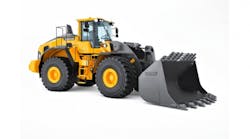In 2000, United Rentals spent more than $800 million on equipment purchases for its rental fleet. Last year, it spent less than half that amount and fleet expenditures for this year are projected for about $350 million.
Although no other rental company buys in those kind of quantities, the pattern was repeated throughout the rental industry with most rental companies spending less than half as much on equipment in 2001 as the previous year and planning to spend the same or less this year. Rental companies throughout North America are finding that their supply of inventory is outpacing demand, leading to downward rate pressure, fierce competition to place equipment on job sites, aging fleets and a lot of relatively late-model iron available for good prices on the used market.
Because of these and other factors, for rental companies this is as good a time to buy equipment as there has been in many years. With manufacturers facing reduced margins and a potential oversupply of equipment sitting dormant in their warehouses and often no alternative to employee layoffs and reduction in production, the need to sell equipment is strong. Interest rates are as low as they've been in years — compare current rates to the 20 percent and higher rates in the recession of the early 1980s. Financing options are plentiful for rental companies with good credit, from a wide variety of sources. Manufacturers are eager to make purchases easier for rental companies and are designing a wider variety of financing options tailored to specific rental company needs, often through their own company infrastructure. Many manufacturers, by their own admission, are bending over backwards to offer attractive terms, with lengthy no-interest or no-payment periods.
“There's no better time than right now,” says Tom Milligan, construction equipment marketing manager for Case Credit Corp., Racine, Wis. “Rates are attractive, there are loans and leases and many kinds of bundled solutions. We're being very aggressive.”
More manufacturers than ever have set up their own captive financing companies. Some, such as Case Credit and John Deere Credit have been in the business for decades, while others were established relatively recently, to take advantage of the profit opportunity and to provide more flexible service to their customers.
“We were having a hard time finding good vehicles to supply financing that could be as flexible as we wanted them to be,” says Lynne Woodworth, president and chief operating officer of Honeoye, N.Y.-based Stone Construction Equipment, which owns its own subsidiary, Stone Financing. “We like to get fast approval because many of our customers expect that these days. We offer very quick turnaround and some sources can't process applications as quickly as we'd like them to.”
Manufacturers were also motivated to form captives because of familiarity with the unique requirements of the rental industry. “It made sense for JLG to create this division because of our deep understanding of this market and the fact that other lenders may not fully appreciate the needs and business models of rental centers,” says Bob Lever, managing director for JLG's Access Financial Solutions subsidiary. “We understand the financial statements and cash flows of rental centers and other equipment owners and are able to adapt our programs as market conditions warrant.”
Lever says manufacturers spend a lot of time explaining the unique debt-to-equity ratios on rental company balance sheets to banks and other lending institutions.
“Rental inventory stays on books for several years, so balance sheets become leveraged because they have an accumulation of rental assets,” Lever says. “It's difficult to finance long-term assets with cash. So while sales companies might have 2:1 debt-to-equity ratios, the balance sheets of rental companies often look like finance companies with assets that stay on the books for a long time. The lending community is accustomed to very different ratios. When we first got started, we spent a lot of time explaining and educating financial institutions about why the profile is so different.”
Harry Schneider, senior vice president of the rental division for Citi Capital, formerly American Equipment Leasing, agrees, adding: “Ratios are different than in other industries. The balance sheet is not as important because equipment can be accelerated on depreciation. Some balance sheets show higher leverage, so we have higher ratios.”
Schneider explains the kinds of ratios financing officials are more likely to look at. “We look at receivables and payables and how fast they're turning them,” he says. “We divide payables by annual sales and determine how long it would take them to pay that bill. If you divide receivables the same way, you can get an average of how long it takes to collect. So if it's stretching out to 75 or 90 days, we take a hard look at that company. We look at the cash flow, the net income plus amortizations and depreciation and compare that to current debt. If there's an excess, you can determine if they can handle additional debt.”
That being said, financing companies, like most manufacturers, take into consideration a company's history. “We'll take a bit more risk with companies we've been through a lot with, companies we've been through the last recession with,” Schneider says. “Those of us that finance the rental industry know that rental companies generally pay well. This industry has high integrity and rental people who have invested their lives into their businesses, are the kind of people who make it work, who will take less salary, work more hours and figure out what it will take to pay and do whatever it takes. Delinquency in the rental industry has always been less than in most other industries.”
Still, manufacturers are well aware that these are riskier times and even though, with all manufacturers, rental companies have to meet credit criteria, suppliers are more willing than usual to assume a bit more risk. “Any time the economy slows down, there's a higher chance of default with rental dealers,” says Corey Garbisch, corporate credit manager for Menomonee Falls, Wis.-based Wacker Corp. “But you have to look at it on a long-term basis. You have to service those dealers or you lose market share. So you have to be willing to assume some risk.”
In addition to assuming more risk, manufacturers, whether they use their own captive financing firms or partner with third-party financers, are far more willing to design programs to the requirements of rental customers. “Each customer and set of circumstances becomes unique, and customization is becoming more of the rule than the exception,” says Milligan.
“There are things we, like many other manufacturers, are willing to do now that we wouldn't do a year ago and might not do a year from now,” says Steve O'Hearn, marketing manager, rental marketing, John Deere Construction & Forestry Division, Moline, Ill. “Everybody is in a survival mode and everybody is trying to sell some iron.”
Most manufacturers are offering a wider variety of options than in the past to appeal to the wider-ranging needs of the rental industries. They are also aware that rental executives, in general, are far better educated than in the past about the types of financing opportunities available to them, within and outside of the industry. “There are a lot more lenders available to this industry than in the past,” says Woodworth. “In the early ‘90s, it was mostly banking institutions and there were fewer available opportunities to smaller rental stores. Now there are hosts of lending options, but a large segment of the market still relies heavily on manufacturers to provide financing.”
Woodworth's Stone is somewhat typical in the variety of options it offers. “We offer contracts for various terms, with interest that allows rental houses to spread payments out over the long term to manage cash flow,” she says. “We have a wide variety of leasing agreements that will go up to five years. There are too many to mention. We offer skip payment leases to help facilitate cold weather climates, cash discounts and dating with 30-, 60- or 90-day deals for net payment. We have the flexibility to put together almost any kind of plan. We're seeing a lot of desire for extended terms.”
“We offer various options based on needs of customers,” adds Hank Eisner, vice president of finance for Carson, Calif.-based Multiquip. “We offer long-term deals of a year or more, generally through Citi Capital, subsidizing interest rates with cash discounts, so we can offer way below prime financing from 12 to 60 months, although 12, 24, 36 months are more normal. If they buy from September to December, they can get the option of no payment until March, and they can have three, four, five or six equals with no interest depending on the size of order.”
Although Multiquip will arrange financing for longer terms if the customer requests it, he points out that long-term deferred payments arrangements can conflict with credit limits. “If a manufacturer gives a customer $100,000 in equipment and after six months he hasn't paid yet and then wants to buy more, the customer might think he's current according to the terms of the deal, but the manufacturer risks having $200,000 of equipment out and still not sure if he's going to get paid. In that case, a leasing plan might work best for both sides.”
Net payment deals are popular, manufacturers say, as are zero-percent interest upfront plans. “We will go from 90 to 180 days without payments,” says Citi Capital's Schneider. “It allows customers to get the equipment out there and get some rental income before they have to start making payments. That product is good in the winter because six months later, in the spring, they're bringing in income. But offering 180 days from the summer without payment goes right into the winter and then when payments are due they have no money coming in. We'd rather give longer terms when payment comes through in the busy season.”
“Manufacturers are subsidizing programs right now, but it's still important for rental companies to understand that nothing is for free and even with no-interest programs, there's still a cost to doing business,” says Tim Cetto of Pinnacle Capital, Wenatchee, Wash. “There are four ways to acquire inventory and the cheapest way is still to pay cash. But the second-cheapest these days might be manufacturer-direct financing.”
“Most popular are our winter buying programs that most manufacturers now have, such as 3 by 3, 6 by 6 or 12 by 12 — 12 equal payments with no interest,” says Chuck Hutchinson, of Bil-Jax, Archbold, Ohio. “That's what we see most of in the marketplace these days. But we're more careful with new customers until they develop a track record with us.”
MTA Distributors, Nashville, Tenn., offers a program it calls Power Forward and Spring Forward. “With the Spring Forward program, from Jan. 1 to April 30, if you place an order for up to $8,500 of anything in our catalog, you get six equal payments with no interest,” says CEO David Ace Harrington. “That way they can get equal payments in the good season. The Power Forward program runs from Sept. 1 until Dec. 31. If you spend a minimum of $5,000, you don't have to pay until March or April, so it can carry you through the winter and then you make two equal payments in March and April.
Also popular now are “walk-away” lease programs where companies have the option to discontinue payment and opt out if a piece of equipment is not bringing a profitable return.
“We check their utilization,” says Angus Davis, CEO of Houston-based ADI Equipment. “They can opt out at any time to keep inventory fresh. If they're not renting, we want to get them something they can rent.”
“The customer is looking for cash flow,” says Deere's O'Hearn. “We offer a walk-away on leasing arrangements, where the customer can walk away at designated time frames beginning after the first 12 months. They can renew the lease, turn back the machine or exercise purchase options.”
Also popular in the current market are requests for trade-ins to manufacturers.
“A lot of rental companies are looking for trade-in packages,” says O'Hearn. “The attitude is ‘take my risk, give me some cash flow and take away my old stuff.’ Companies are running into more maintenance issues because they are keeping the equipment a lot longer. Depending on the appetite of the heavy-equipment manufacturer, trade-in packages can include non-earthmoving equipment or like-kind competitive units. Even aerial equipment manufacturers are taking in earthmoving trades. The attitude is ‘Take my tired, under-utilized or upside-down inventory and we have a deal.’ Everybody wants to shift the risk.”
While taking on the customers' risk is nobody's idea of a sound business practice, manufacturers know that if they don't at least consider the customers' demand, they are likely to find another manufacturer that will in this buyers' market. And, as O'Hearn says, in this market, manufacturers will do a lot of things they wouldn't normally do. At least for now.
Michael Roth can be reached at [email protected].


